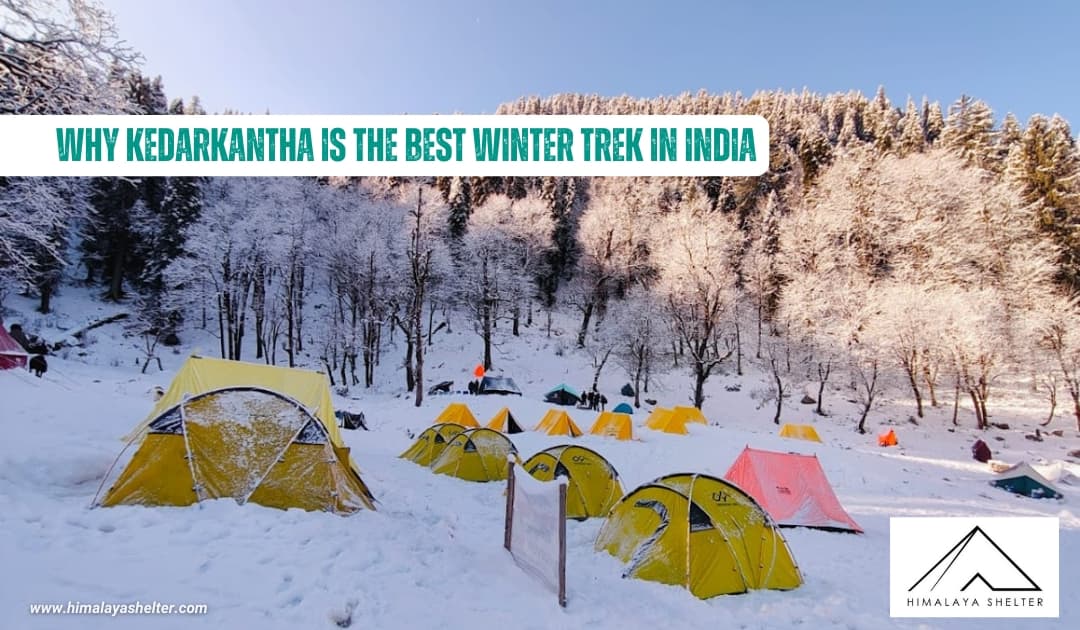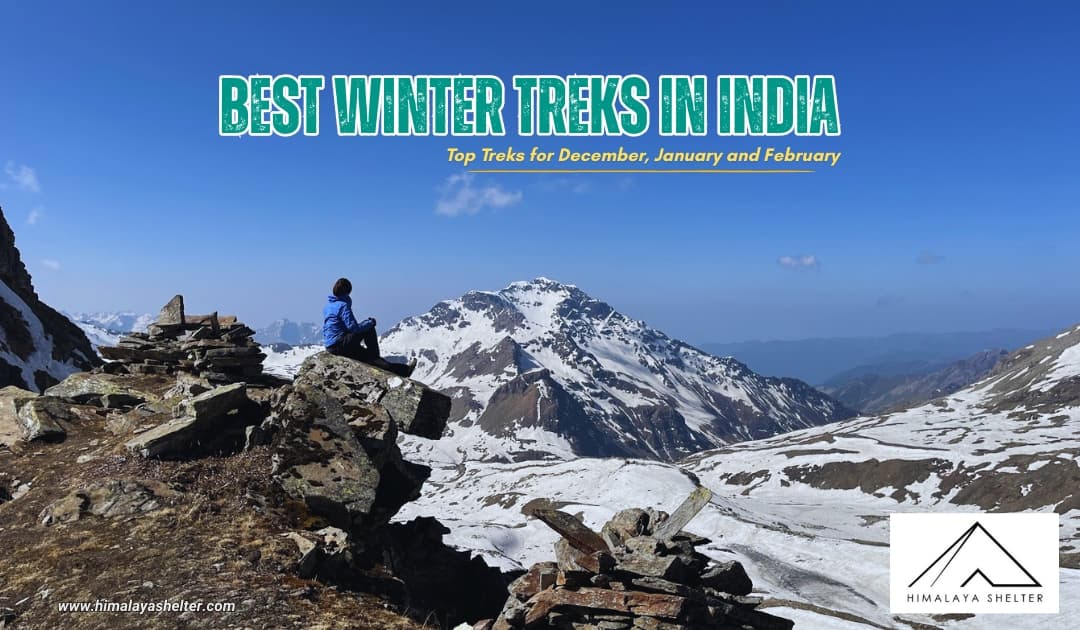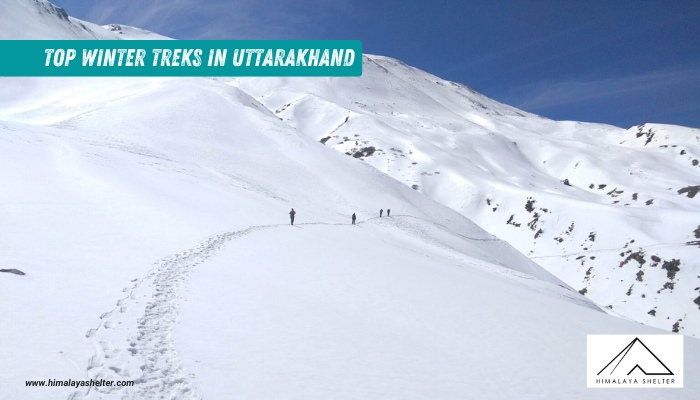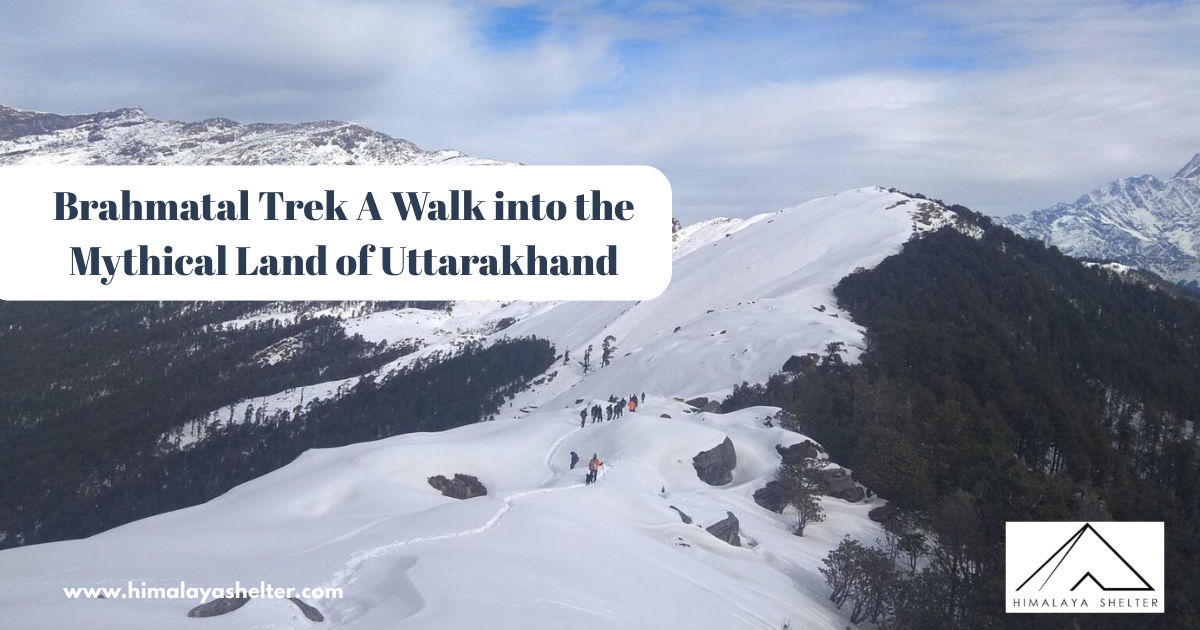
Brahmatal Trek
TREK DIFFICULTY
Easy - Moderate
TREK DURATION
6 Days
HIGHEST ALTITUDE
12,250 feet (3,734 meters)
GROUP SIZE
12
TREK DISTANCE
24 Km
BASECAMP
Brahmatal, Uttarakhand
BEST TIME
December to early February
PICKUP POINT
Dehradun (Prince Chowk)
Brahmatal Trek Overview:
Out of many mesmerizing experiences of the Himalayas, the Brahmatal Trek is sure amongst the few on the list of favorites for all trekkers. “Tal” means lake and “Brahma “means the god of creation. This lake has been named after Brahma the supreme in the triad of great Hindu gods which includes Shiva and Vishnu.
The Brahmatal Trek is particularly popular during the winter season from December to March. The Summit of Brahmatal trek offers some breathtaking views of Silvery snow-dressed mountains and clear blue skies to enjoy the 360 degree stunning views of the Himalayan ranges, including peaks like Trishul and Nanda Ghunti.The lake gets frozen during winter season and its beauty multiplies multifold. Most of the treks in Uttarakhand during this season, are in snow and the white snowy meadows and terrain are exciting to explore. Also, The Brahmatal trek offers trekkers an opportunity to immerse themselves in the authentic lifestyle of traditional villagers and explore lush oak and rhododendron forests.

The Starting point of the trek is Lohajung which can be accessed via Kathgodam. This is the base camp for the Brahmatal trek. To reach Lohajung, we cross Nainital and the winding mountain roads passing through forest-laden areas are particularly interesting. As per the Legend Goddess Parvati and a demon named Lohasur had a war and hence this place is named Lohajung. “ Jung” means “war”.
Another interesting destination of this trek is Bekaltal, another beautiful lake en route to Brahmatal summit. The trail crossed through some snow-covered forest during the winter season and since this trail is comparatively unexplored it adds to the thrill of the entire experience. Some breathtaking views of gorgeous meadows offering views of Majestic Mt. Trishul and Mt. Nanda Ghunti are a part of this hiking program.
Lohajung is the starting point of the trek and serves as the base camp for the Brahmatal Trek in Chamoli, a district in Uttarakhand, India. Here are graphs that will provide information about the elevation gained each day of the hiking.
- Day 1- Drive from Dehradun to Lohajung
- Distance: 393 km
- Altitude Gain: 1466 ft to 7,600 ft
- Day 2- Trek from Lohajung to Gujreni
- Distance: 4.5 km
- Altitude: 7,600 ft to 9,200 ft
- Day 3- Gujreni to Tilandi
- Distance: 3 km
- Altitude: 9,200 ft to 10,495 ft
- Day 4- Tilandi to Brahmatal via Brahmatal top
- Distance: 5.5 km
- Altitude: 10,495 ft to 10,190 ft via 12,250 ft
- Day 5- Brahmatal to Lohajung
- Distance: 8.5 km
- Altitude: 10,190 ft to 7,600 ft
- Day 6- Drive from Lohajung to Dehradun
- Distance: 393 km
- Altitude Gain: 1466 ft to 7,600 ft
The hike traces routes over snow-carpeted forests, meadows, and lakes - as if you are in a true winter fairy tale.
The Brahmatal Lake is one of the top attractions of the trek where you can marvel at the magnificence of frost as the lake is frozen up during winter months and offers fantastic scenery.
As you journey through this exuberance of nature, you will meet rich flora and fauna as thick oak and rhododendron forest will appease your eyes, and you may spot Himalayan Monals, Musk deer, and Snow leopards, a few of them scattered.
The walk is spread over five nights and six days, culminating in an elevation of five thousand four hundred and seventy-eight feet, from Lohajung to Brahmatal Top. You will reach an altitude of 12,250 feet at the Brahamtal Top, from where you can enjoy mesmerizing views of Mt Trishul, Mt Nanda Ghunti, Mt Chowkhamba, and Mt Neelkanth. Next to the Brahmatal, there is a place called Bekaltal, a hidden glacier lake.
Points to Remember:
- Documents Required: Trekkers should carry a copy of the Aadhar Card (Indian National) or a copy of the Passport and visa(International Tourist) along with the Medical Certificate signed by a Doctor.
- Accommodation: Trek stays in an A-Shape tent/ North Face Tent. Built to withstand extreme weather conditions and, at the same time, make you comfortable after a hard day’s trek.
-
- Do not litter the Mountains. Kindly carry all the non-biodegradable bags with you and throw them in the dustbin.
- Please do not feed animals (especially dogs) with biscuits.
- Biscuits can cause health issues; their fur starts shedding, which makes it difficult for them to survive in the winter.
- Cloakroom: We have a cloakroom facility available for extra luggage. Every trekker is permitted to leave their luggage behind at no charge.
Below are some of the main highlights that trekkers can experience during the trek.
-
Snow-covered landscape in winter:
Snow-covered forests, meadows, and the frozen lake of Bekal Lake are sure to captivate you as you journey through the winter wonderland. The pristine white landscapes create a breathtaking atmosphere on the Brahmatal trek. -
High-altitude lake:
This trek takes you to the beautiful Brahmatal Lake which is situated at an altitude of 12,200 feet above sea level. Situated at a high altitude, this lake remains frozen during the winter months. Witness the crystal-clear snow scene and have a wonderful view of a frozen lake amidst the Himalayas. Also, one the way you will you will see Bekaltal which is one of the best attractions of the Brahmatal Trek. -
Enchanting Rhododendron Forest:
Wander through Rhododendron forests that burst with colors, especially during spring. The vibrant foliage adds to the trekking experience. Trek through dense forests of oak and rhododendrons and get a chance to spot wildlife species like the Himalayan monal, musk deer, and even the elusive snow leopard.
The Rhododenron Tree (Rhododenron Arboreum), with its outstanding beauty, is a rich adornment to contributes to the biodiversity of nature found during the Brahmatal trek.
The journey of the trekkers into the wilderness gets a beautiful, unreal touch in vibrant colors delivered by These trees. Known as Burans or Laligurans are a treat to the eyes, particularly in spring when they explode with reds and pink petals.
In the months of spring season, from March to May typically, Brahmatal trek blooms like a canvas colored with rhododendron flowers. The trail is flanked along these ways by magnificent trees, perfect scenery truly connotating the image of wilderness in this part. -
Easy to moderate trek:
Brahmatal trek is suitable for both beginners and experienced trekkers. Its well-defined trails make it an exciting adventure for everyone. -
Views of Mount Trishul and Mount Nanda Ghunti:
Throughout the trek, view and enjoy the breathtaking views of Mount Nanda Ghunti, Mount Trishul, and Mount Neelkanth. These majestic peaks are among the highest mountains in the world. Their snow-covered peaks add to the attraction of the visit.

Brahmatal Trek Route Map
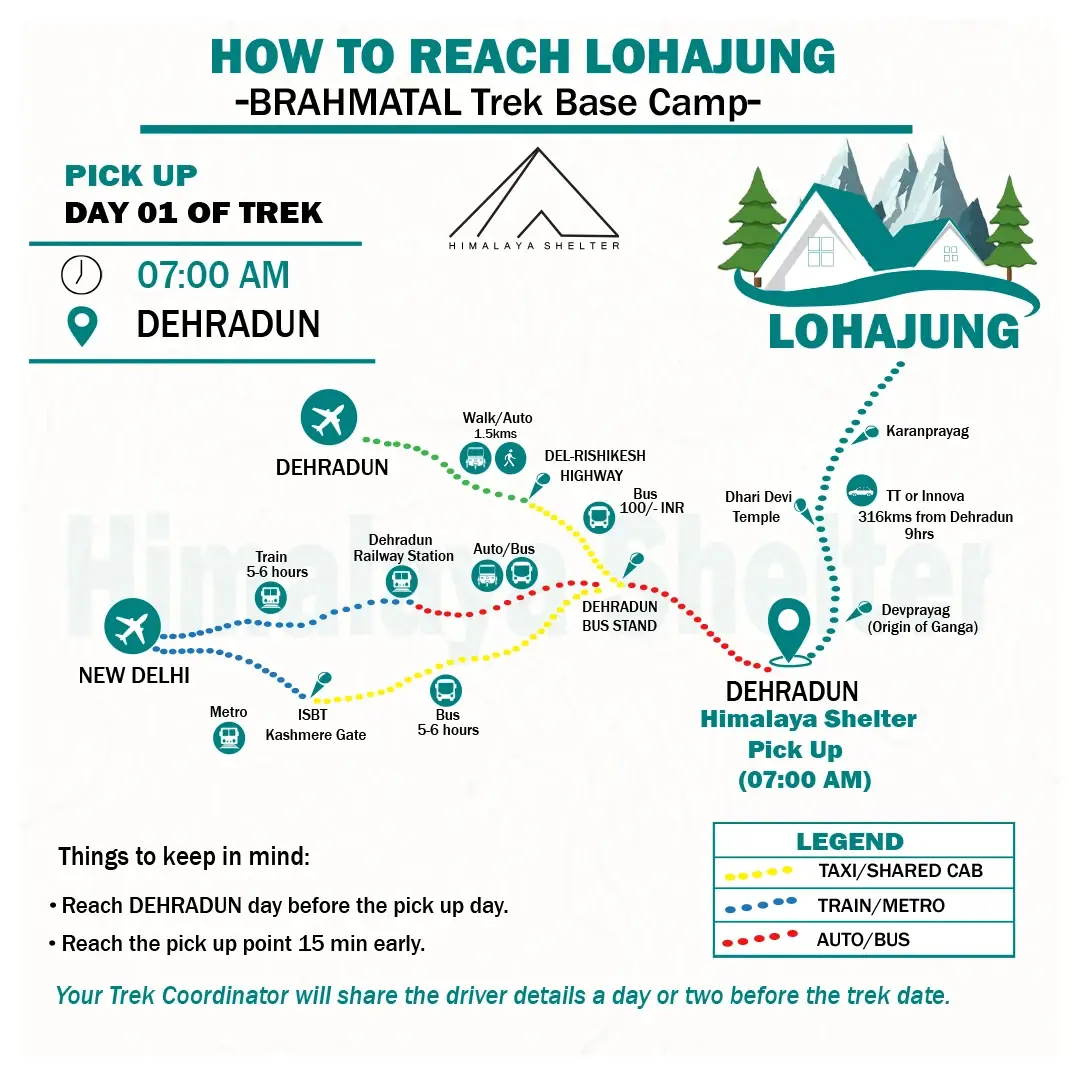
How to Reach Brahmatal Trek
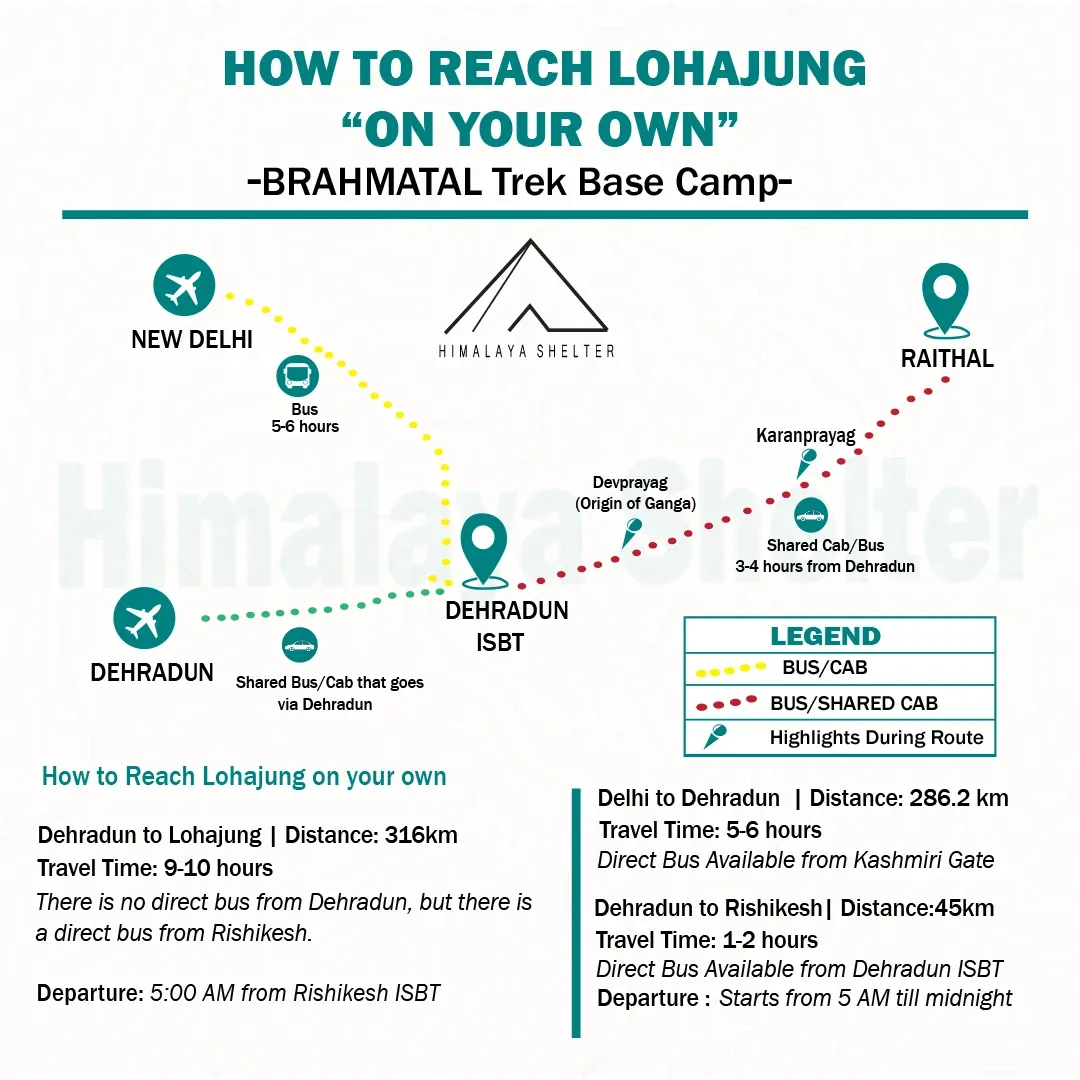
How to Reach Brahmatal on your own

How to Reach Dehradun by Train For Brahmatal
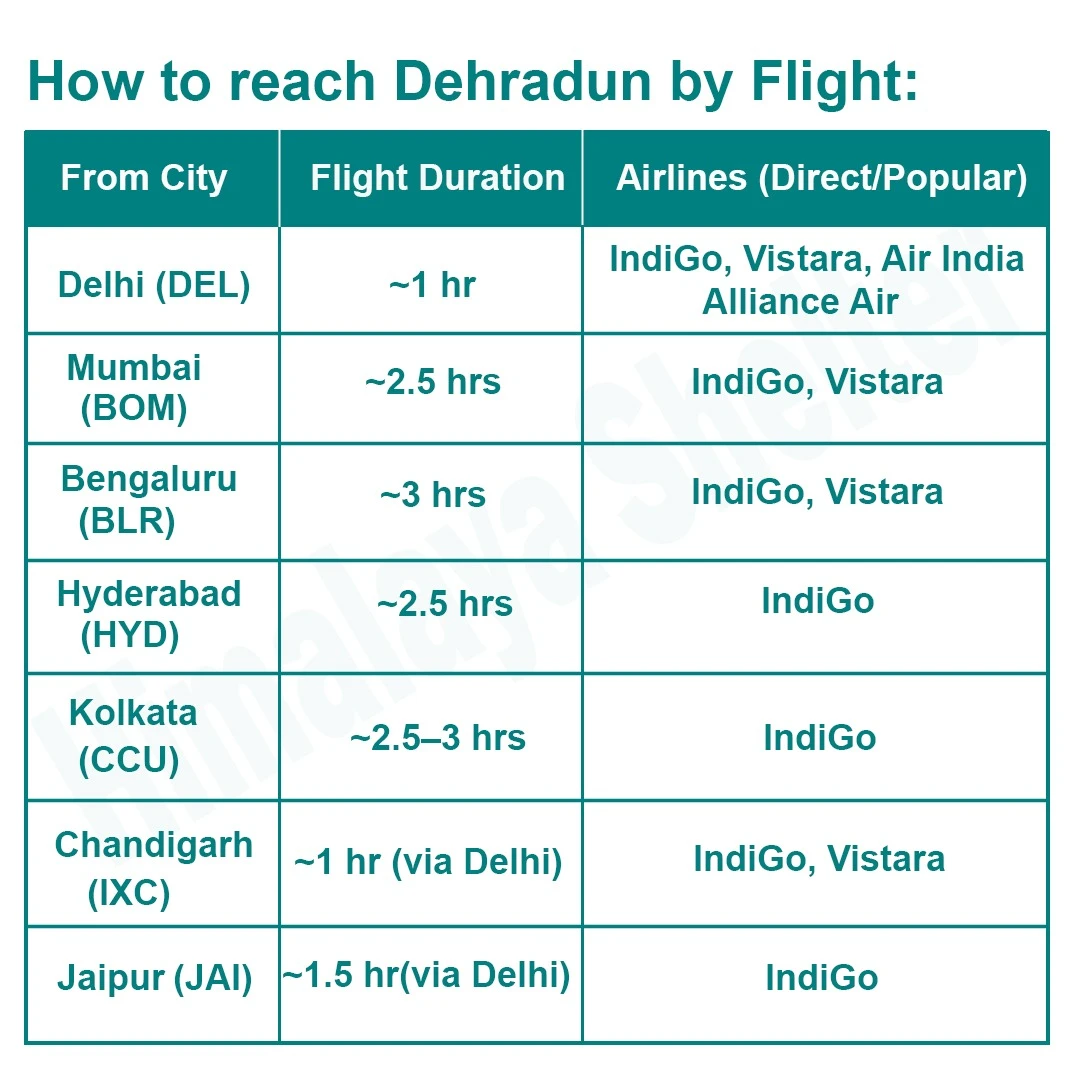
How to Reach Dehradun by Flight For Brahmatal
The Brahmatal trek is a notch less difficult than easy-moderate treks like Kedarkantha and Dayara Bugyal. Therefore, It is considered easy to moderate level trek in terms of difficulty. During the Brahmatal trek, you will cover a distance of approximately 23 km in four days and summit an altitude of approximately 4,650 feet. On average, you will travel 7 km every day, which will include ascents and descents.
It is very important to remain physically fit; otherwise, you will miss the beauty of this trek due to fatigue. Although the level of difficulty goes up when you are trekking in snow, similarly at Brahmatal, the level of difficulty increases when you are trekking in snow.
In winter, you will hike this trail buried in knee-deep snow. However, it does not require the support of technical staff. Safety on the Brahmatal TrekThe itinerary of the Brahmatal Trek allows you to acclimatize well. When climbing a peak through thick snow, make sure you wear microspikes. Hard snow has a high probability of slipping. A small mistake can result in injuries like ligament tears, ankle sprains, or even fractures. Always place your feet on the footings made by earlier trekkers. Look for deep bottoms. Don't try to create new paths for yourself.
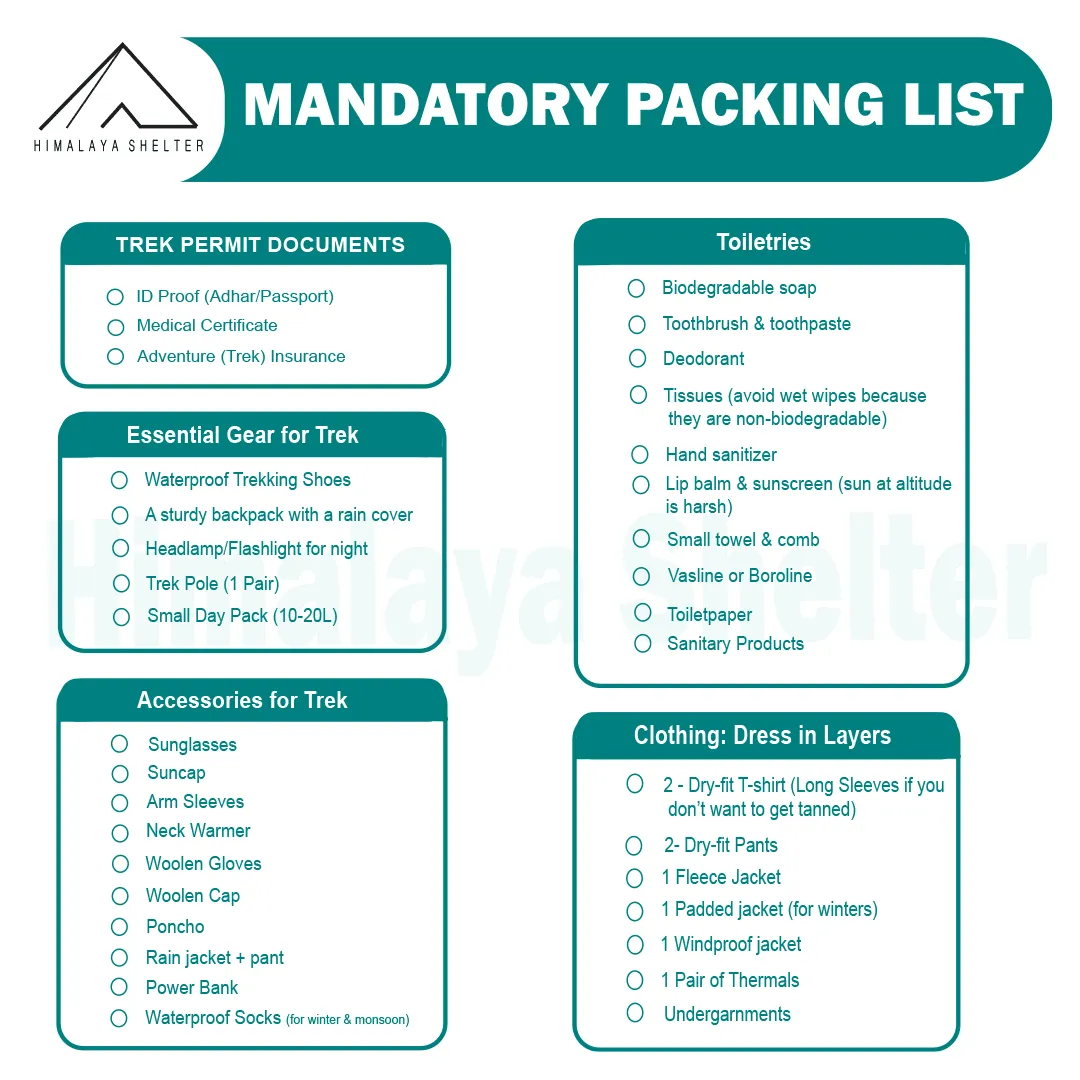
Backpacking List of Brahmatal Trek
Notice: All trekkers are strictly advised not to carry unnecessary plastic items such as disposable bottles, single-use cutlery, polythene bags, and food wrappers during the trek. We encourage the use of reusable bottles, tiffin boxes, and cloth bags to minimise waste and protect the fragile Himalayan ecosystem. Your cooperation is essential in ensuring a clean and sustainable trekking experience.
The challenging terrain requires careful planning and adherence to safety precautions to ensure a safe and enjoyable trekking experience. Here is a list of 11 essential safety precautions and protocols for the Brahmatal Trek:
1. Acclimatization:
- Importance: Acclimatization helps stabilize oxygen levels in the body. It is crucial for preventing altitude sickness and maintaining physical fitness.
- Protocol:
- Spend an extra day at the Lohajung base camp or intermediate points to adjust to the altitude (if required).
- Ascend gradually, avoid ascending too quickly.
- Climb high and sleep low. After reaching the campsite, hike to a higher elevation than the campsite's altitude, spend some time there, and then return to the campsite.
- Reduce strength exercises and increase yoga practice with Pranayama or other slow breathing techniques.
2. Weather Preparedness:
- Importance: The weather during the Brahmatal Trek can be unpredictable, with sudden rainfall and variation in temperature. Knowing weather facts helps trekkers determine the best time to start or not start their trek, and be prepared for any expected weather fluctuations during the hiking.
- Protocol:
- Check weather forecasts regularly.
- Be prepared for sudden changes by carrying appropriate gear, such as waterproof jackets or a poncho, warm fleece, and extra pairs of quick-dry socks.
- In the mountains, afternoon rain is more common than other times of the day. So, make sure to start and end your hike before noon.
- If it’s raining continuously, pause on the hike on the spot but avoid stopping near water streams and narrow valleys. Try to pass away these areas as quickly as possible.
3. Hydration and Nutrition:
- Importance: Staying hydrated and well-nourished helps maintain energy and health.
- Protocol:
- Drink plenty of water at regular intervals throughout the trek.
- Carry high-energy, easy-to-digest foods like nuts, energy bars, and fruits.
- Avoid taking alcohol.
- Avoid consuming sugary foods or drinks during the trek. Excess sugar increases blood glucose concentration, leading to fatigue.
4. Health and First Aid:
- Importance: Immediate response to health issues can prevent serious complications.
- Protocol:
- Carry a comprehensive first aid kit, including altitude sickness medication, and be familiar with basic first aid procedures.
- Inform your trek leader of any pre-existing health conditions.
5. Safety Gear:
- Importance: The right gear can prevent injuries and keep you safe in adverse conditions.
- Protocol:
- Wear sturdy, broken-in trekking boots with good ankle support.
- Dress in layers to manage your body temperature.
- Carry a reliable backpack with a rain cover and other essentials such as a headlamp, rope, oxygen cylinder, gaiters, and microspikes.
6. Emergency Preparedness:
- Importance: Quick action is vital in emergencies.
- Protocol:
- The nearest hospital is located in Dewal Block, which is nearly 28 km from the Lohajung base camp.
- Keep emergency contact numbers.
- Ensure that your trek leader has communication devices such as a satellite phone or walkie-talkie in case of an emergency. Also, whenever you get a mobile network, keep updated the basecamp or your emergency contact person.
- Make sure you have appropriate adventure insurance that covers trekking in high-altitude areas.
7. Navigation and Trail Safety:
- Importance: Navigating high altitudes and challenging trails requires caution and skill.
- Protocol:
- Follow your guide.
- Follow marked trails and use a compass, maps, or GPS devices to avoid getting lost on the trail.
- Pay attention to trail markers and avoid venturing off the path.
8. Wildlife Awareness:
- Importance: Encounters with wildlife can be a risk.
- Protocol:
- Maintain a safe distance from animals.
- Avoid leaving food unattended and keep your campsite clean to avoid attracting wildlife.
9. Group Coordination:
- Importance: Staying connected with your group ensures collective safety.
- Protocol:
- Maintain regular communication with your group.
- Follow the trek leader’s instructions and avoid separating from the group.
10. Environmental Responsibility:
- Importance: Protecting the natural environment is essential.
- Protocol:
- Follow "Leave No Trace" principles.
- Dispose of waste properly and avoid disturbing wildlife or vegetation.
11. Altitude Sickness Awareness:
- Symptoms: Headache, nausea, dizziness, and shortness of breath.
- Protocol:
- If symptoms occur, inform your trek leader immediately.
- Descend to a lower altitude if necessary and seek medical help if symptoms persist.
- On the Brahmatal Trek, there are less chances of altitude related sicknessess. Also, you ascent gradually each day of hiking which helps you to be fully acclimitazation. Still, if any symtoms occurs, keep your walking pace slow and steady untill you reach back to the basecamp or a lower altitude campsite.
Adhering to these safety precautions and protocols will help ensure a safe and memorable experience on the Brahmatal Trek. Proper preparation and awareness are key to navigating the challenges of this beautiful Himalayan adventure.
If you’re physically fit and aware of the safety precautions for the Brahmatal Trek, you’ll experience the beauty of this trek 200% more effectively compared to those with weaker physical fitness and insufficient knowledge of safety precautions. This preparation enables you to fully enjoy the majestic landscapes and challenging trails without being held back by fatigue or physical limitations.
Physical Fitness Preparation for Trek:
To overcome the difficulty level of Brahmatal Trek, it requires strong cardiovascular endurance, muscular strength, and overall physical fitness. Incorporate these exercises into your routine to increase strength, stability, and stamina, which will help you tackle difficult terrain sections of the trail at high altitudes.
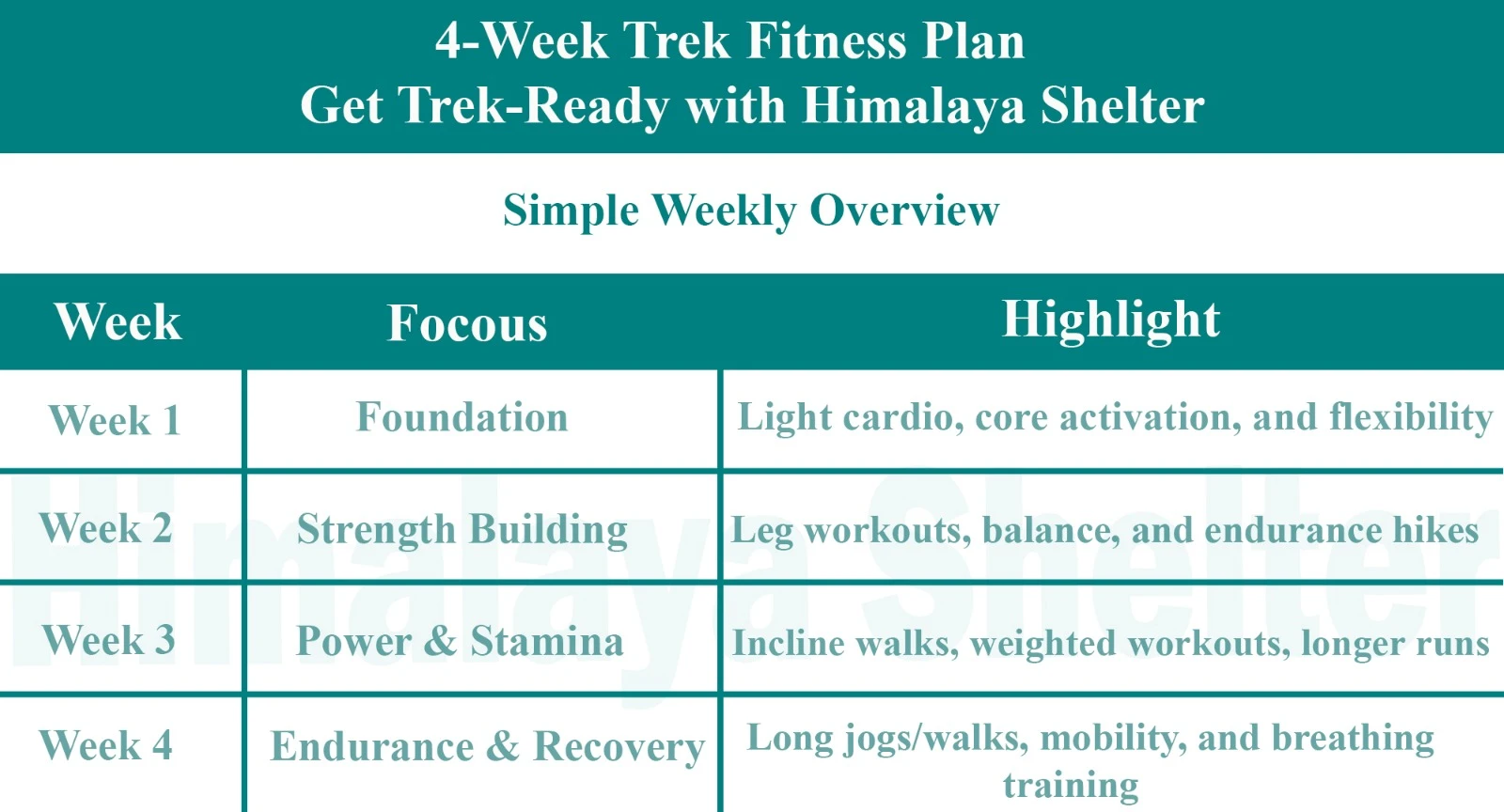
Overview
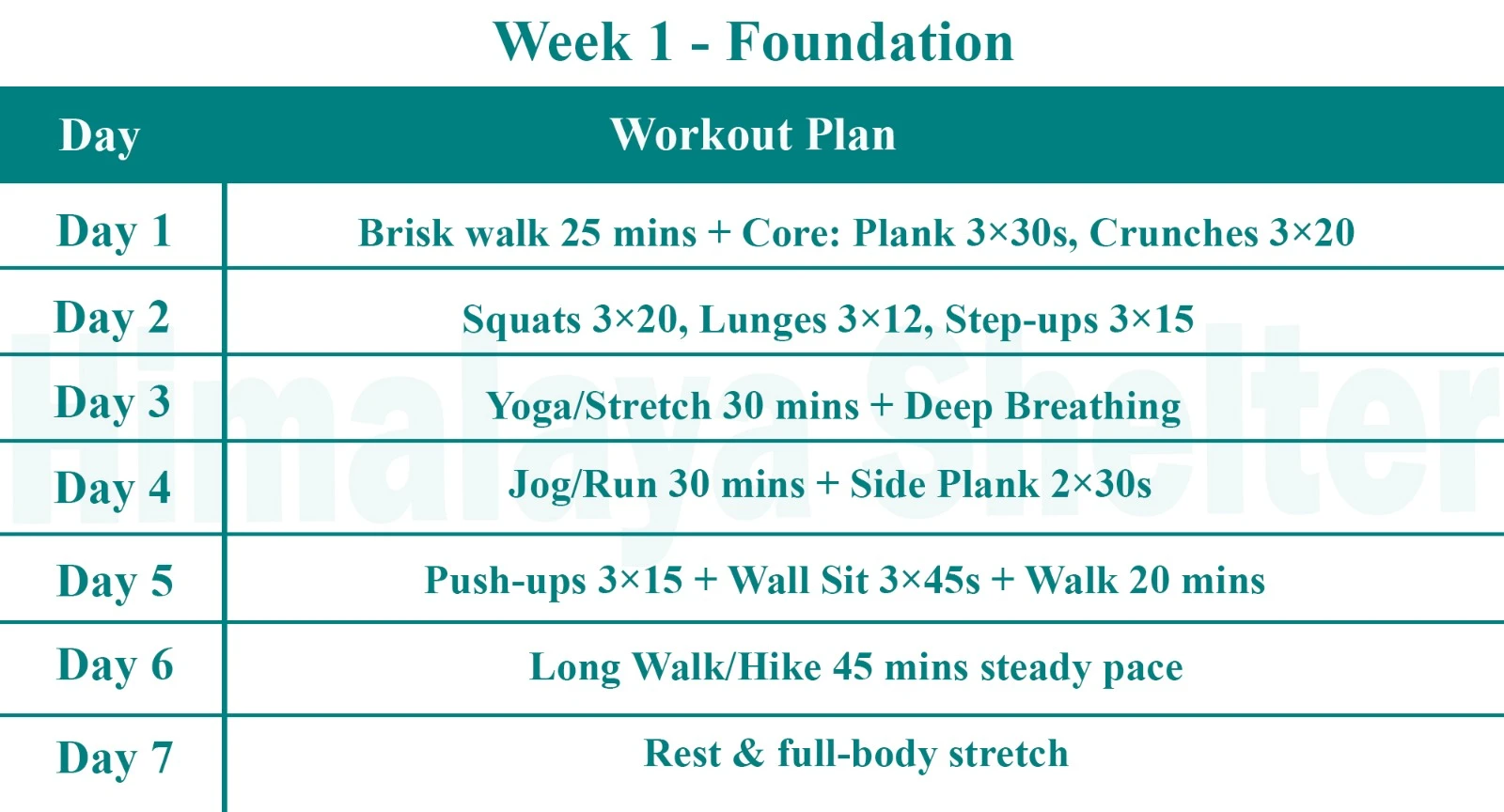
Foundation
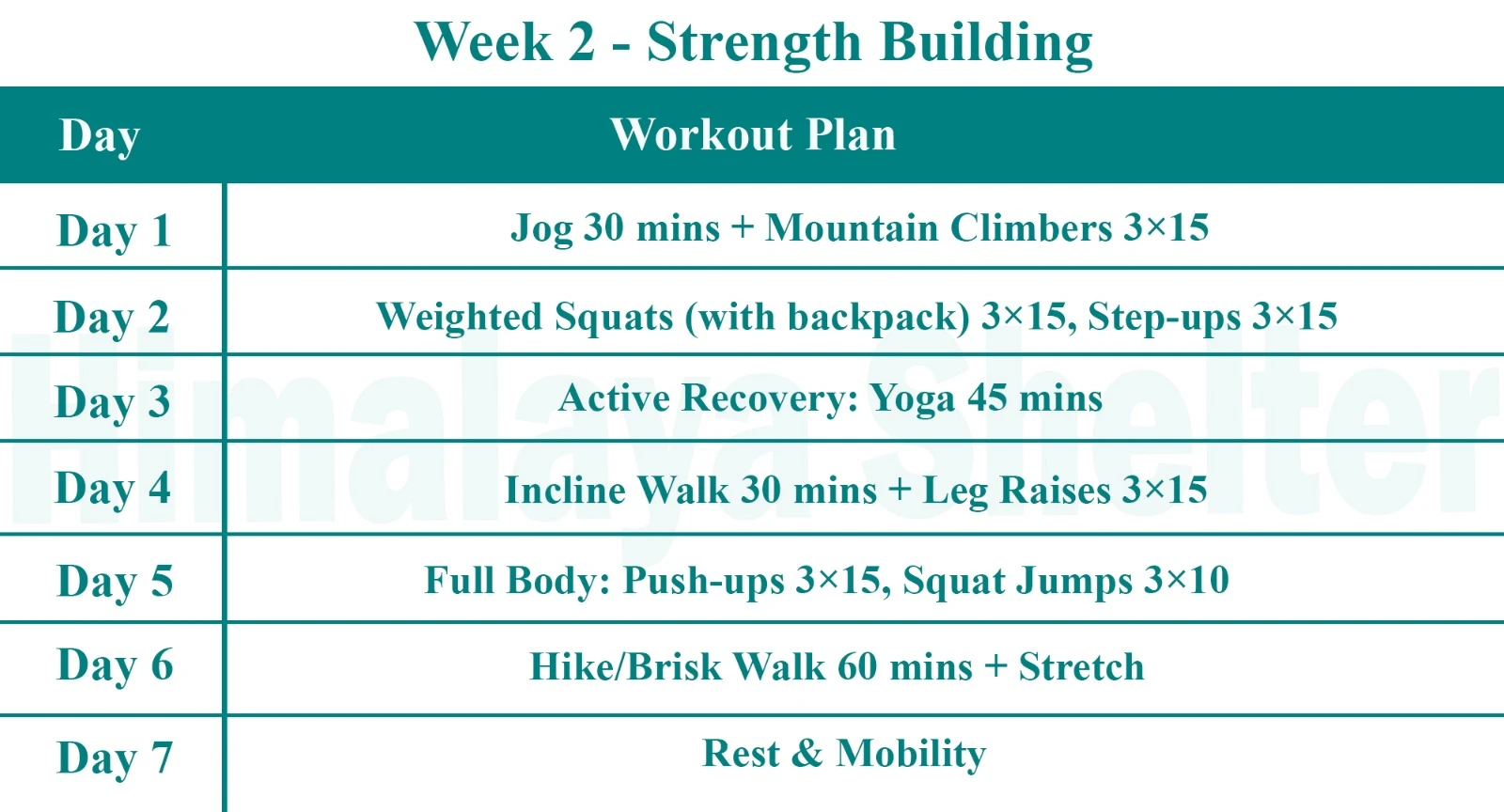
Strength & Building

Power and Stamina

Endurance & Recovery
5. Additional Tips:
- Consistency & Form: Maintain proper technique and gradually increase intensity.
- Recovery & Flexibility: Allow muscle recovery, and stretch before and after workouts.
- Balance Training: Incorporate strength exercises like deadlifts for overall balance and endurance.
Regularly performing these exercises will build the necessary strength and stamina for a successful trekking experience. Good fitness is crucial for tackling the challenges of the Brahmatal Trek and fully appreciating the adventure it offers.
Day 1: Drive from Dehradun to Lohajung (7,600 ft)
Drive: 290 km, 10- 11 hrs
Early in the morning, we will depart for Lohajung. Travelling through the Himalayan roads will be a mesmerizing experience for you. In the evening, we will arrive in Lohajung and check into the guesthouse. Lohajung serves as the base for the Brahmatal Trek. We will have plenty of time to rest and prepare ourselves for the trek.
Day 2: Trek from Lohajung to Gujreni (9,200 ft)
Trek: 4-5km, 5 hrs
Post Breakfast, we will begin our trek from Lohajung. Hiking through rhododendron and oak forests we will reach to the Gujreni where will set our camp. Gujreni is a picturesque campsite surrounded by oak trees, rhododendrons, and wildlife. The trail enters thick oak forests with glimpses of Mt. Trishul. Khopdalia, a small dried lake, is reached after an hour and a half through the forest.
Bekaltal, just above Khopdalia, is a ten-minute trek away. It’s encircled by dense oak trees, and its brown waters indicate high dissolved organic matter. Brown lakes like this are often light-limited and may be acidic with limited aquatic life.
Day 3: Gujreni to Tilandi (10,495 ft)
Trek: 3 km, 4-5 hrs
Today’s trek is a relatively short one, commencing at the campsite and heading southwest. Shortly after starting, you’ll cross a stream, and then the trail begins a steep ascent through the captivating Oak and Rhododendron forest. On your left, a ridge reveals the valley below, while Bekaltal is on your immediate right. As you continue the climb, Rhododendron trees dominate the scenery in the first half of the trail, gradually giving way to Oak trees. After about an hour of trekking through this stunning forested section, you’ll reach the tree line and enter the meadows. Here, you’ll be treated to a breathtaking panoramic view of Mt. Trishul and Mt. Nanda Ghunti, along with their surrounding ranges. At the edge of the meadows, you’ll find a ridge that serves as your Tilandi campsite.
Day 4: Tilandi to Brahmatal (10,190 ft) via Brahmatal top (12,250 ft)
Trek: 6km, 7-8 hrs
The day’s trek leads you along a ridge, with the treeline shifting as you ascend and descend. Rhododendron and Oak trees dominate the landscape. As you continue along the ridge, you’ll be greeted by majestic mountains and sweeping valleys, with layers of mountain ranges unfolding before you, creating an unmatched sense of openness. Following the right trail from Jhandi Top, you’ll ascend another mountain ridge to reach the trek’s highest point, Brahmatal Top at 12,250 ft, where you can relish the awe-inspiring vistas. Descending gradually, you’ll reach the stunning Brahmatal Lake, often with a captivating reflection of the night sky if it’s not frozen. The Brahmatal campsite, situated at 12,250 ft, is just 500 meters to the left of the lake on the slope, offering a perfect vantage point for witnessing a mesmerizing sunset.
Day 5: Brahmatal to Lohajung (7,600 ft)
Trek: 9km, 7-8 hrs
After breakfast, start descending from Brahmatal Lake towards Lohajung. The trail is relatively open with sparse vegetation until you reach Jhandi Top, where you’ll have occasional mountain views during your ascent. From Jhandi Top, take the left trail for your descent to Lohajung. Initially, you’ll pass through an open area, losing sight of the mountains. After about a kilometre, you’ll re-enter the treeline, now surrounded by Oak trees. Khorurai, a clearing named after oaks, makes for a good rest spot and a potential campsite if you want to extend your trek. After another 1.3 kilometres, you’ll rejoin the main trail, descending through a Rhododendron forest. Follow the well-maintained path connecting mountain villages to Lohajung, crossing two streams along the way. About an hour from the start, you’ll reach Shepherd huts, locally known as ‘chawni,’ used by villagers and shepherds to shelter their livestock. Continue following the man-made trail, connecting these mountain villages to Lohajung. At Lohajung we will stay in a guest house.
Day 6: Drive from Lohajung to Dehradun
Drive: 290km, 10-11 hrs
Today, we will greet the rising Sun and have an early breakfast. Going back home is always a bittersweet moment, but the journey is made easier by taking the same picturesque road back to Dehradun. As we leave behind the dense pine forests and descend towards the city, the landscape slowly changes and opens up into wider roads. Finally, we will arrive in Dehradun in the evening.
Package Inclusion of Brahmatal Trek
Our treks are specially designed by the experienced team at Himalaya Shelter, taking you on an adventure of a lifetime all while making you connect not only with the bountiful nature but also with yourself and with others on the trek with you creating wonderful memories which will last you a lifetime. All Himalaya Shelter treks are guided by experienced Trekkers having vast knowledge and experience of the region, providing with insightful information and stories pertaining to the region’s flora and fauna and the history of the region whilst the trek. It is safe to say that on successfully completing the trek, one will gain tremendous insight and experience along with lifetime memories.
- Transport Support ( Vehicle- Tempo Traveler/Bolero, drive from Dehradun/Rishikesh to Lohajung )
- Accommodation – At Base Camp, stay at a local homestay or guest house for one night each, which will give you an insight into the authentic lifestyle of the locals.( INR 5000 per person extra for single sharing throughout the trek )
On Trek stay in a 2-person Vango Halo Pro/A-Shape tent, which is to be shared by two trekkers, built to withstand extreme weather conditions and at the same time making you comfortable after a hard day’s trek. - Camping Equipment – specially designed sleeping bags that can withstand harsh weather conditions, foam mattresses. Other safety gear like microspikes, gaiters, an ice axe, and helmets will be provided.
- Medical Kit – our team will be equipped with an extensive medical kit, which our team is trained and experienced to use. Oxygen cylinders are used after they are thoroughly inspected throughout the Trek. Even campsites have large oxygen cylinders as backups.
- Permission - Forest entry charges for Indian nationals (Additional charges will be applicable for international tourists)
- Meals – Breakfast, packed lunch (on trek days), evening snacks, and dinner will be served. A hearty, delicious, and nutrition-filled Veg meals with egg preparation will be provided throughout the trek. (Jain and Vegan Food can also be arranged on prior notification.)There will be a dedicated Kitchen Tent along with a dining tent, which will have a dining table too.
- Our Team – A highly experienced and AMC-certified Trek Leader who will help ensure that the entire trek goes smoothly and safely while navigating the challenging conditions during the trek, and is skilled enough to navigate any medical emergency that can arise during the trek. Local and route Guides who are well-versed with the region and provide an in-depth insight into the local customs and knowledge of the flora and fauna endemic to the region. A dedicated Kitchen staff, which includes a Cook, a helper, and other support staff. There will also be porters and mules to carry common equipment.
- Cloakroom - We have a cloakroom facility available for extra luggage. Every trekker is permitted to leave their luggage behind at no charge.
Exclusions of the Package
- Personal expenses like tips, personal medicines, phone calls etc.
- Travel Expenses - Travel expenses from your hometown to the mentioned Pick-Up Point are not included in the trek fee.
From the scheduled pick-up spot to the base camp, we have our own fleet of vehicles like Bolero, Innova, Dezire, or Tempo Traveler (12-seater). This is be shared by trekkers for a pre-decided amount. All vehicles are non-AC. - Personal Equipment - Any personal gear like jackets, shoes, cutlery, or backpacks are not included in the trek fee. We recommend renting them from our Rental Store for an affordable fee. This can be pre-arranged to avoid last-minute hang-ups.
- Offloading - We encourage carrying your backpack to get into the true spirit of trekking. However, if needed, you can opt to offload your personal luggage of up to 12 kgs for an additional cost of INR 400 per bag per day.
- Trek Insurance - A mandatory trek insurance fee is charged in addition to your trek fee. Since most medical insurance doesn’t cover adventure activities, trek insurance offers essential coverage, enhancing your safety without a significant financial burden.
- Buffer day on the trek - We have kept a buffer day on the trek to account for any weather-related delay. If this is utilized, you will need to pay an extra amount to your trek leader.
- Anything apart from inclusions
- Please carry a lunch box for a packed lunch/breakfast to avoid using polythene and Aluminium foil.
Keeping the Himalayas clean is our own responsibility. Reduce the use of Plastic when you are in the abode of the Sacred Himalaya. 🌱
Read More on Brahmatal Trek
Photo Gallery








Treks by Categories
Treks By Month

Treks By Experience

